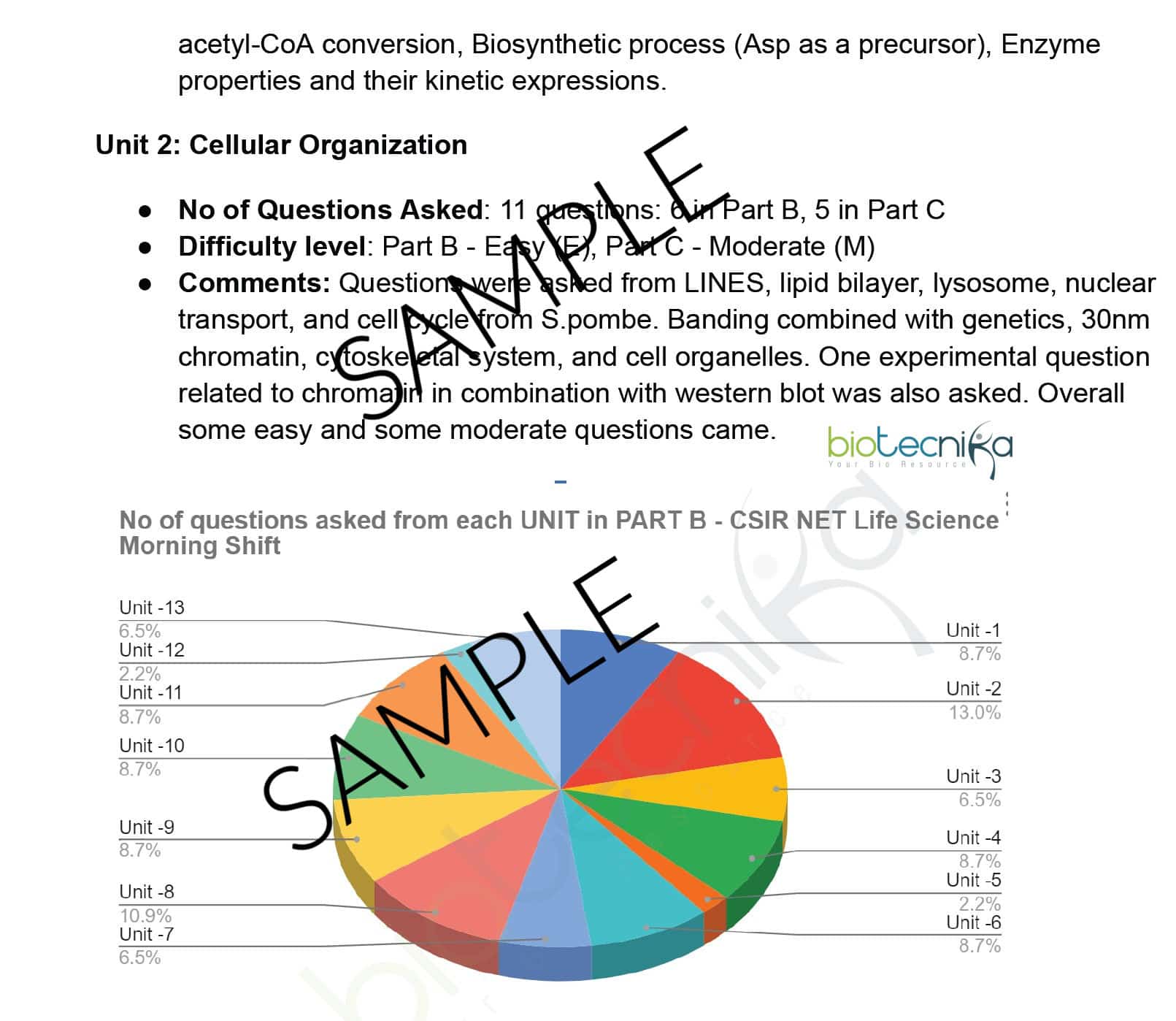CSIR NET Difficulty Level of Questions in JUNE 2023 Exam
Welcome to our comprehensive resource for CSIR NET June 2023 aspirants! In this article, we provide a summary of the CSIR NET June 2023 Life Science question paper analysis for both the morning and evening shifts. However, if you desire a more in-depth report that includes detailed information such as the number of questions asked from each unit, the types of questions encountered, and the unit-wise difficulty level, in that case, we invite you to fill up a simple form below and download the complete analysis PDF.
Expected Cut off for CSIR NET June 2023 Life Science Exam
Based on the analysis of the CSIR NET June 2023 Life Science question paper, the expected cut-off for this year’s examination is estimated to be 52.7% for the LS category and 56.8% for the JRF category. These projected cut-off marks provide candidates with a benchmark to assess their performance and chances of qualifying for the prestigious CSIR NET. It is important to note that the cut-off may vary depending on various factors, including the difficulty level of the exam and the overall performance of the candidates. Aspirants are advised to keep these
projected cut-off marks in mind while evaluating their results and planning their future course of action.By downloading the CSIR NET June 2023 Complete Question Paper Analysis, you can:
- Evaluate your performance: With a detailed analysis of the question paper, you can assess your strengths and weaknesses in each unit. This will enable you to identify areas that require further improvement and revision.
- Understand difficulty levels: The analysis provides an overview of the difficulty levels for each unit, allowing you to gauge the overall complexity of the exam. This insight will help you strategize your preparation for future attempts.
- Gain valuable insights: The comments from fellow candidates provide valuable insights into the nature of the questions, emphasizing conceptual clarity, analytical skills, and the importance of specific topics. These comments can guide your preparation for upcoming exams.
- Determine expected cut-off marks: The expected cut-off marks give you an estimation of the minimum score required to qualify for the CSIR NET June 2023 exam. This information helps you gauge your performance and understand the level of competition.
Prepare yourself for success and take a step closer to achieving your academic goals by downloading the complete analysis PDF. Gain a thorough understanding of the CSIR NET June 2023 question paper and equip yourself with the insights necessary for a focused and effective study strategy!
CSIR NET June 2023 Unit-wise Question Paper Analysis in Brief: Morning Shift
UNIT 1: Molecules and their Interaction Relevant to Biology:
- The difficulty level of the questions was moderate.
- Questions required conceptual clarity and had a mix of direct and numerical-based questions.
- Topics covered included Reducing sugars, Physical properties of solvent & solubility of salts, Glycolysis, and Standard free energy.
UNIT 2: Cellular Organization:
- Part B questions were easy, while Part C questions were moderate.
- Questions covered topics such as LINES, lipid bilayer, lysosome, nuclear transport, cell cycle, and chromatin.
- An experimental question related to chromatin in combination with western blot was also asked.
UNIT 3:Fundamental Processes
- The difficulty level of the questions was easy.
- Questions were direct and covered topics like DNA replication, SOS repair, Operon, and Translation factor.
UNIT 4:Cell Communication and Cell Signaling
- The difficulty level of the questions was moderate.
- Questions covered topics like GPCR, JAK-STAT, MAPKinase, chimeric antigen receptors (CARs), and Mycobacterium.
- A mix of easy to moderate questions were asked.
UNIT 5:Developmental Biology
- Part B questions were moderate, while Part C questions were difficult.
- Questions covered topics such as sea urchin gastrulation, blastomere fate in C. elegans, and amphibian early embryonic development.
- In-depth understanding of species-specific development was required.
UNIT 6:System Physiology – Plant
- Part B questions were easy, while Part C questions were moderate.
- Questions covered topics like characteristic traits found in sun- or shade-acclimated leaves, glycolysis, photosynthesis, nitrogen metabolism, and stress physiology in plants.
UNIT 7:System Physiology – Animal
- Part B questions were easy, while Part C questions were moderate.
- Questions were mainly statement-based and related to the nervous system, including nerves associated with the heart, respiration, and excretion.
UNIT 8:Inheritance Biology
- Part B questions were moderate, while Part C questions were difficult.
- Questions covered topics like trans-cis gene configuration, molecular markers, gene mapping, and chromosome banding.
- Some questions combined different concepts for analysis.
UNIT 9: Diversity of Life Forms
- Part B questions were easy, while Part C questions were moderate.
- Part B questions were direct and memory-based, covering topics like habitat types, geographic origins, and migrations of species.
- Part C questions required conceptual clarity and covered topics like species conservation, angiosperm characters, and chlorophytes’ structural diversity.
UNIT 10: Ecological Principles
- The topics covered in Part B were biodiversity, survivorship curves, invasive species, and methods of population estimation.
- Part C covered Simpson’s reciprocal index, ecosystem productivity, global CO2 concentration, species-area relationship, environment-water conditions, net primary productivity (NPP) of ecosystems, ecological dispersion, food chains, and metapopulation.
UNIT 11: Evolution and Behavior:
- Part B questions were easy, while Part C questions were moderate.
- Questions covered topics like sexual selection, reproductive isolation, Hardy-Weinberg equilibrium, and analysis of phylogenetic trees.
- No questions were asked from paleontological history.
UNIT 12: Applied Biology:
- Part B questions were moderate, while Part C questions were difficult.
- Questions included agrobacterium-based topics and matching questions related to National Parks/Sanctuaries.
UNIT 13: Methods in Biology:
- The difficulty level of the questions was moderate.
- Part B questions were direct and required conceptual clarity.
- Part C questions included matching, statement-based, and figure-based questions that required analytical skills.
- Topics covered various techniques in molecular biology, microscopy, field biology, and bioinformatics.
Overall, the question paper had a mix of easy, moderate, and difficult questions across different units. It required a solid understanding of the concepts and topics from each unit to answer the questions effectively.
CSIR NET June 2023 Question Paper Analysis in Brief: Evening Shift
The evening shift of the CSIR NET June 2023 examination presented a diverse range of questions across various units. Here’s a summary of the question paper analysis for the evening shift:
Unit 1: Molecules and their Interaction Relevant to Biology
- Part B: Questions were direct but required conceptual clarity, covering topics like DNA helix conformation, hydrogen bonds, and post-translational modification.
- Part C: Questions involved statements, figures, and numericals, testing knowledge in areas such as amino acids, enzyme kinetics, and citric acid cycle.
Unit 2: Cellular Organization
- Questions covered lipid bilayer, aquaporins, bacterial culture, and nuclear/ER transport. Part B questions were easy, while Part C questions were challenging.
Unit 3: Fundamental Processes
- Questions focused on DNA replication, repair, introns, promoter location, and post-transcriptional modification. The difficulty level varied from easy to moderate.
Unit 4: Cell Communication and Cell Signaling
- Topics included effector dynamics, aging-related insulin signaling, FACS analysis, immunophenotyping, viruses, and host receptors. Some questions were unexpected and required a deeper understanding.
Unit 5: Developmental Biology
- Questions involved gastrulation, limb formation, and amphibian development. Most questions were statement-based, testing knowledge in developmental processes.
Unit 6: System Physiology – Plant
- Topics covered ABA, plant defensin genes, visible spectra, secondary metabolites, photosynthesis, cytokinin, SAR, ROS in plant defense, and solute transport. Questions were predominantly statement-based.
Unit 7: System Physiology – Animal
- Questions focused on clotting factors, parathyroid hormone, spermatogenesis, respiratory pigments, cardiovascular system, and thermoregulation. A mix of statement-based and matching questions was present.
Unit 8: Inheritance Biology
- Questions covered plant classification, zoological nomenclature, structural organization, endangered species, phylogenetic trees, and distribution in India. The difficulty level varied from moderate to difficult.
Unit 9: Diversity of Life Forms
- Topics included plant classification, apomorphic studies, rare species, and dispersal. Questions tested knowledge of phylogenetic trees and the distribution of organisms.
Unit 10: Ecological Principles
- Questions involved population measurement, succession mechanisms, ecological conservation, community diversity, and island biogeography. Some questions were challenging.
Unit 11: Evolution and Behavior
- Topics covered population genetics, introgression, circadian rhythm, cognitive responses, adaptive traits, and evolutionary ideas. Questions required understanding of evolutionary concepts.
Unit 12: Applied Biology
- Questions focused on fermentation, agrobacterium, transgenic plants, and marker-assisted selection. The difficulty level was moderate.
Unit 13: Methods in Biology
- Part B questions were direct, covering techniques like ELISA and fluorochromes. Part C questions involved circular dichroism, NMR, confocal microscopy, and restriction digestion. Some questions combined concepts from different units.
The evening shift of the CSIR NET June 2023 examination presented a mix of easy, moderate, and difficult questions across different units. Candidates were required to demonstrate conceptual clarity, analytical skills, and a deep understanding of the topics. The question paper provided a comprehensive evaluation of candidates’ knowledge in the field of life sciences.






























